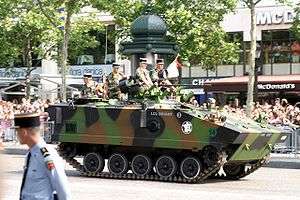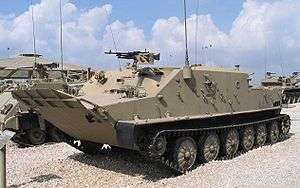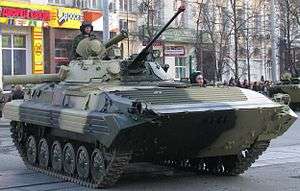Indonesian Marine Corps
| Korps Marinir | |
|---|---|
|
Coat of Arms of the Korps Marinir | |
| Active | 15 November 1945 |
| Country |
|
| Allegiance |
|
| Branch |
|
| Type | Naval Infantry |
| Part of |
|
| Nickname(s) | KORMAR, Purple Berets |
| Motto(s) | Jalesu Bhumyamca Jayamahe (Sanskrit) : On the Water and Land, We are Glorious |
| Colours | Purple |
| Anniversaries | 15 November |
| Engagements | Various anti-guerrilla operations in Indonesia, including Aceh and East Timor |
| Website | Official Site |
| Commanders | |
| Commander-in-Chief | President Joko Widodo |
| Commandant | Major General R.M. Trusono |
The Indonesian Marine Corps (Indonesian: Korps Marinir) officially known as KORMAR or simply "Marinir", Tentara Nasional Indonesia - Angkatan Laut, ("KORMAR", TNI-AL); officially translated as: Marine Corps, Indonesian Navy[1] is the currently integral part of the Indonesian Navy (TNI-AL) and sized at the military corps level unit as the Naval Infantry and main amphibious warfare force of Indonesia. There are future plans to expand the Indonesian Marine Corps to become an independent, uniformed force. It is commanded by a two star marine general (nothing that it does not use the Admiral title). It has two divisions, which are:
- Pasukan Marinir I / "PASMAR I" (Marine Force I) based in Jakarta for operations in the western fleet of Indonesia
- Pasukan Marinir II / "PASMAR II" (Marine Force II) based in Surabaya for operations in the eastern fleet of Indonesia.
The two marine divisions (PASMAR I and II) are each led by a one star admiral (Brigadier General/Commodore).
History

Starting from the establishment of the Corps Mariniers (CM), the predecessor of the marine corps on 15 November 1945 at Navy Base IV of ALRI (Angkatan Laut Republik Indonesia]] in Tegal. The marine corps was initially formed as a training for Indonesian seamen who joined the Navy, in order to fight on the ground when there is an emergency. The marine eventually was forced to join guerrilla warfare on land due to lack of sea defense equipments. In other places, the Navy infantry were widely known as the "ALRI Gunung" (Navy of the Mountains) because it is more frequent fighting in the jungle and the foot of the mountain, rather than at sea. But they are not included yet in the marine corps for this latest new corps at that time only exist in Navy Base IV in Tegal, not in other naval bases. The marine corps from Tegal sent troops to Semarang front of the Revolution 25 times to aid the People's Security Army (TKR) who was losing to the Dutch. In the midst of the revolutionary period, precisely on 17 March 1948 there have been a reorganization and rationalization of the marine corps. At that time, because the marine corps have a lot of combat experience on the ground, the government decided to separate it from the Navy.
Corps Mariniers was then merged into the Diponegoro Division of the army by the name of Samudera Regiment and was divided into five battalions. Marine soldiers who wishto remain in the navy must submit a written request to the Minister of Defence and Commander in Chief of the Armed Forces Car. On October 9, 1948, the Minister of Defense ratified Decree No. A / 565/1948, declaring the establishment of the marine corps. Nevertheless, the acceptance of new personnel only started after the Round Table Conference (RTC) in 1949. Selection reception was held at the main naval base in Surabaya. Approximately 1,200 recruits were selected to join the new naval amphibious forces. After being examined, it turns out 95 percent of the 1,200 people who received it are personnel are formerly part of the Corps Mariniers established in Tegal. Of all the personnel of the Korps Komando Operasi Angkatan Laut (KKO AL) recorded in 1950, 90 percent of the personnel were formerly part of the Corps Mariniers . Therefore, the existence of marine Corps formed in 15 November 1945 as mentioned in the previous paragraphs, justified as the forerunner of the Navy Marine Corps today.[2]
The marine crops has been active in various military operations in Indonesia. One of the largest amphibious military operations would have been Operation Jayawijaya in which thousands of marines were planned to land on Biak in 1963 as a part of the Trikora Campaign to take West Irian from Dutch control. The operation was aborted as a consequence deals preceding the New York Agreement.[3]
At the height of the Indonesia-Malaysia Confrontation, Harun Hj Mohd Said and Usman Ali (hereinafter known as Usman Harun), two members of the Marine Corps were dispatched to Singapore using rubber boats. Their main task is to infiltrate and sabotage the interests of Malaysia and Singapore. In practice, these operations are only able to blow up the MacDonald House and cause civilian and non-military casualties. In that incident, 20 fruit shops around the hotel was heavily damaged, 24 pieces sedan vehicles were destroyed, 30 people died, 35 people suffered serious injuries and mild. This incident is known as the MacDonald House bombing. Usman and Harun were unable to escape from Singapore and was eventually arrested and sentenced to death by the Singapore government.[4]
In 1999 a plan was proposed to expand the Kormar from its strength of 13,000 troops. Based on this plan, every Kormar's base would have three combat brigades: the Infantry, Cavalry, and Artillery and would be supported by one Combat Support Regiment and one Administration Support Regiment. The expansion will create three Kormar bases: Surabaya for Eastern area command, Jakarta for Central area command, and Rate Island in Lampung for Western area command. Now the Indonesian Marine Corps has an estimated 29,000 troops in two Marine Forces (PASMARs) and one independent infantry marine regiment, when combined equal to one over-strength infantry division, which includes its own sizeable mechanised amphibious and artillery units.
Following a reorganisation introduced in March 2001, the corps consisted of the 1st Marine Corps Group (1,3,5 Battalions) at Surabaya, and the Independent Marine Corps Brigade (2,4,6, Battalions) at Jakarta.(JDW 11 April 2001). The 8th Bn was formed in January 2004 and the 9th Bn was due to be formed in April 2004. They were planned to be part of a new group that would include the 7th Bn and support elements. (JDW 18 February 2004, p. 18) The same Jane's Defence Weekly story (Robert Karniol, 'Indonesia Reinforces Marines') said the Marine Corps leadership is reported to have ambitions for the service to expand to at least two full divisions. However it was reported that the army was opposed, 'perhaps reflecting its leadership's concern over influence.'
Organisation

2 Marine Forces plus one independent brigade (forming as part of Ten Year Defence Plan 2004-13)
- 1st Marine Force (HQ : Surabaya Marine Base)
- 1st Marine Infantry Brigade with 1st, 3rd, and 5th Marine Infantry Battalions
- 1st Marine Cavalry Regiment
- 1st Marine Artillery Regiment
- 1st Marine Combat Support Regiment
- 1st Marine Administration Support Regiment
- 1st Amphibious Recon Battalion
- 2nd Marine Force (HQ : Jakarta Marine Base)
- 2nd Marine Infantry Brigade with 2nd, 4th, and 6th Marine Infantry Battalions
- 2nd Marine Cavalry Regiment
- 2nd Marine Artillery Regiment
- 2nd Marine Combat Support Regiment
- 2nd Marine Administration Support Regiment
- 2nd Amphibious Recon Battalion
- 3rd Marine Independent Infantry Brigade (Piabung, Lampung)
- 7th, 8th, 9th Marine Infantry Battalion
- 10th Marine Infantry Battalion - Setoko Island, Batam
- 3rd Marine Force (HQ : Sorong West Papua)
Indonesian Marine Commando
Commandants of the KORMAR
| Rank | Name | From | Until | Remarks |
|---|---|---|---|---|
| Rear Admiral | Agoes Soebekti | 1945 | 1950 | |
| Major General KKO | R. Soehadi | 1950 | 1961 | |
| Lieutenant General KKO | Hartono | 1961 | 1968 | |
| Lieutenant General KKO | Moekijat | 1968 | 1971 | |
| Major General | H. Moh. Anwar | 1971 | 1977 | |
| Lieutenant General TNI (Mar) | Kahpi Suriadiredja | July 1977 | May 1983 | |
| Major General TNI (Mar) | Muntaram | May 1983 | Januari 1987 | |
| Major General TNI (Mar) | Aminullah Ibrahim | January 1987 | August 1990 | |
| Major General TNI (Mar) | Baroto Sardadi | August 1990 | November 1992 | |
| Major General TNI (Mar) | Gafur Chaliq | December 1992 | April 1994 | |
| Major General TNI (Mar) | Djoko Pramono | April 1994 | February 1996 | |
| Lieutenant General TNI (Mar) | Suharto | February 1996 | 1999 | |
| Major GeneralTNI (Mar) | Harry Triono | 1999 | 20 November 2002 | |
| Major GeneralTNI (Mar) | Achmad Rifai | 20 November 2002 | 9 November 2004 | |
| Lieutenant General TNI (Mar) | Safzen Noerdin | 9 November 2004 | 6 June 2007 | |
| Lieutenant GeneralTNI (Mar) | Nono Sampono | 6 June 2007 | 18 October 2008 | |
| Major GeneralTNI (Mar) | Djunaidi Djahri | 18 October 2008 | 3 September 2009 | |
| Lieutenant GeneralTNI (Mar) | Alfan Baharudin | 3 September 2009 | 12 September 2012 | |
| Major GeneralTNI (Mar) | A Faridz Washington | 12 September 2012[5] | 2015 | |
| Major GeneralTNI (Mar) | Buyung Lalana | 2015 | 2016 | |
| Major GeneralTNI (Mar) | R.M. Trusono | 2016 | now |
Heavy Equipment
| Name | Image | Role | Origin | Versions | Quantity | Notes |
|---|---|---|---|---|---|---|
| Tanks | ||||||
| PT-76 |  |
Medium tank | |
PT-76B | 70[6] | All re-gunned with Cockerill 90mm with assistance from private company and received improved fire control system and engine upgrade. Not all operational. |
| Armoured vehicle | ||||||
| AMX-10P |  |
Infantry fighting vehicle | |
AMX-10P Marine (90mm, 20mm & 12.7mm variants) | 54[7][8] | |
| BTR-50 |  |
Amphibious armoured personnel carrier | |
BTR-50PK | 70[7] | All upgraded with new engine, radio system and smoke grenade launchers on some vehicles.[9] |
| BTR-80 | _(cropped).jpg) |
Armoured personnel carrier | |
BTR-80A | 12[10] | Currently deployed by Indobatt Contingent on UNIFIL mission in Lebanon. |
| BMP-2 |  |
Infantry fighting vehicle | |
BVP-2 | 40[11] | |
| BMP-3 | |
Infantry fighting vehicle | |
BMP-3F
BREM-L |
54[7][8] | |
| LVT7 |  |
Armoured personnel carrier | |
LVT-P7A1 | 10[12] | All donated from South Korea. |
| BTR-4 |  |
Armoured personnel carrier | |
BTR-4M BAU Parus module
BTR-4M RCWS turret |
5(50)[13][14] | On order. |
| K-61 |  |
Amphibious vehicle | |
K-61 (PTS) | Unknown | [15] |
| PTS | |
Amphibious vehicle | |
PTS-10 | Unknown | [16] |
| Artillery | ||||||
| RM-70 | |
Multiple Rocket Launcher | |
RM-70 Grad
RM-70 Vampir |
17 | 9 RM-70 Grad acquired around 2003, 8 new RM-70 Vampir acquired in 2016[17][18] |
| LG1 |  |
Howitzer | LG1 Mark I | 20 | ||
References
- ↑ http://www.marinir.mil.id
- ↑ "NEWS STORY: Riwayat Marinir yang Pernah Dipisahkan dari TNI AL"
- ↑ Indonesian report in Reuters archives: INDONESIA: OPERATION "DJAJAWIDJAJA" OF THE NAVY.
- ↑ TNI AL, Lemah di Laut tapi Ingin Berkuasa di Darat
- ↑ IDB. "Sertijab Dankormar". Retrieved 24 December 2014.
- ↑ http://koarmatim.tnial.mil.id/index.php?option=com_k2&view=item&id=2780:37-unit-tank-bmp-3f-rusia-kembali-perkuat-alutsista-tni-al&Itemid=191
- 1 2 3 NurW. "DEFENSE STUDIES". Retrieved 24 December 2014.
- 1 2 "Russia to deliver 37 BMP-3F amphibious armoured infantry fighting vehicles to Indonesia". 27 January 2014.
- ↑ "Indonesian Marines BTR-50PK, with some modifications like the smoke dischargers."
- ↑ "BTR-80A : Monster Amfibi Korps Marinir". IndoMiliter. Retrieved 24 December 2014.
- ↑ "BMP-2 : Tank Amfibi "Sangar" & Battlle Proven". IndoMiliter. Retrieved 24 December 2014.
- ↑ "PRINT KOMPAS". Retrieved 24 December 2014.
- ↑ SpetsTechnoExport of Ukraine awarded contract to supply 5 BTR-4 8x8 armoured to Indonesia - Armyrecognition.com, 24 January 2014.
- ↑ "Ukraine to supply 50 BTR-4 armoured personnel carriers to Naval Forces of Indonesia (TNI AL)". March 15, 2014.
- ↑ K-61 : Si “Penyambung Lidah” Operasi Amfibi Korps Marinir
- ↑ PTS-10 : Kendaraan Angkut Amfibi Terbesar Korps Marinir TNI AL
- ↑ http://www.marinir.tnial.mil.id/index.php?berita=detail&id=2001
- ↑ RM70 Vampir: MLRS Terbaru Artileri Marinir TNI AL, Andalkan Platform Heavy Truck Tatra T815-7
